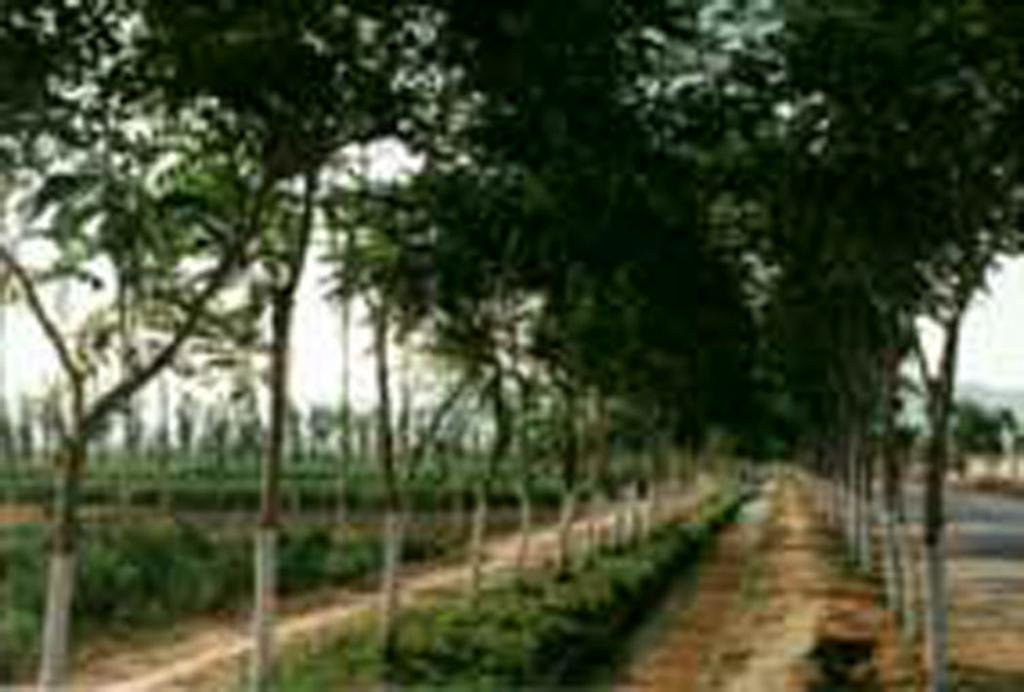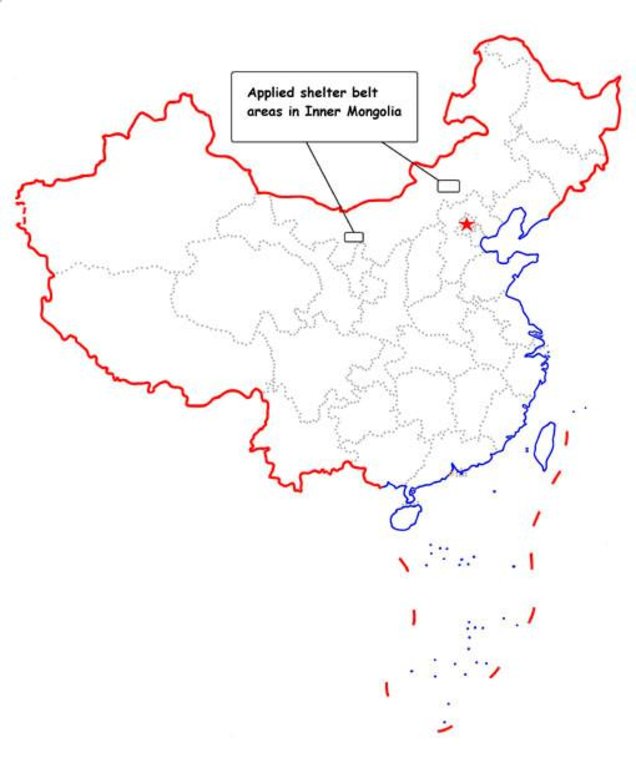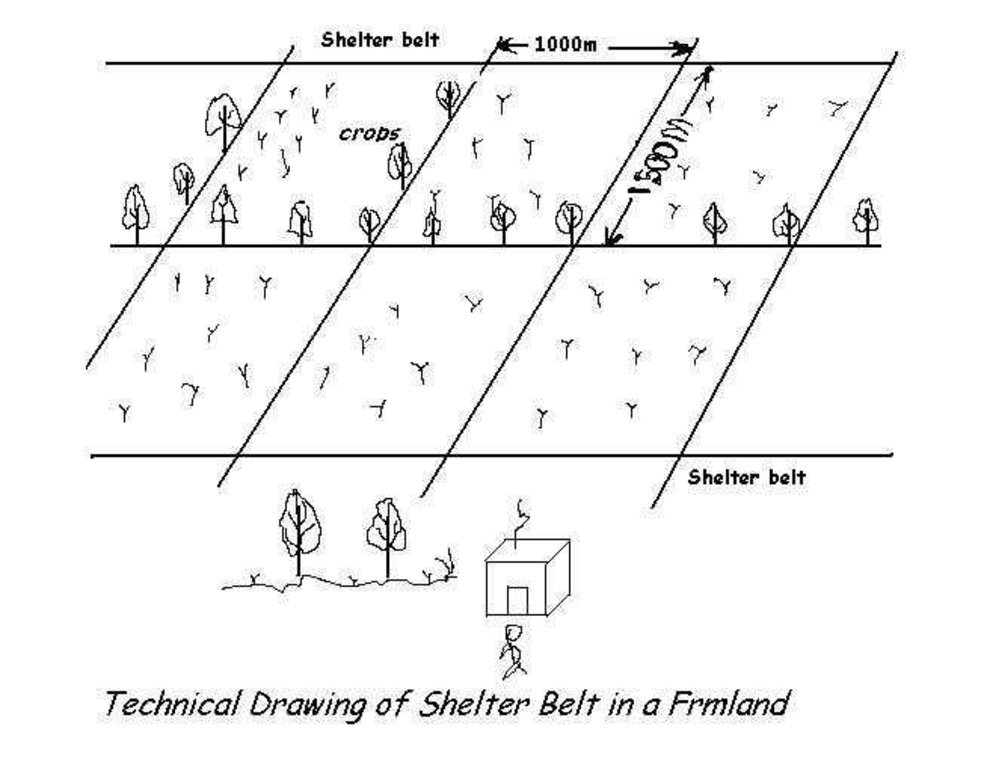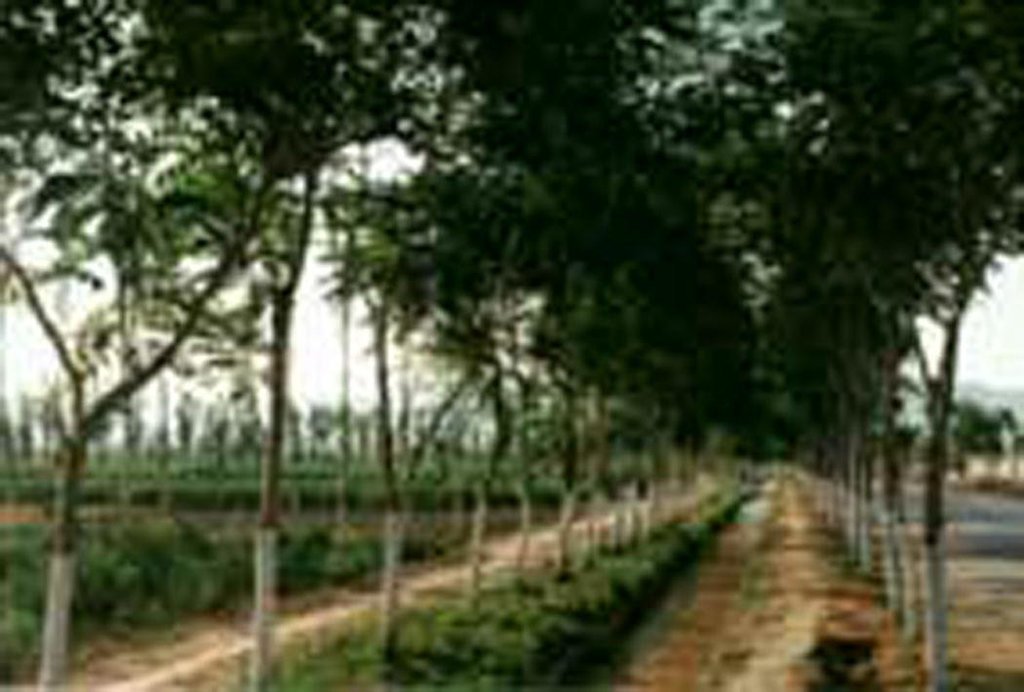Shelter Belt [China]
- Creación:
- Actualización:
- Compilador: Meili WEN
- Editor: –
- Revisor: David Streiff
approaches_2396 - China
Visualizar secciones
Expandir todo Colapsar todos1. Información general
1.2 Detalles de contacto de las personas de referencia e instituciones involucradas en la evaluación y la documentación del Enfoque
Nombre de la(s) institución(es) que facilitaron la documentación/ evaluación del Enfoque si fuera relevante)
Department of Resources and Environmental Science, Beijing Normal University (Department of Resources and Environmental Science, Beijing Normal University) - China1.3 Condiciones referidas al uso de datos documentados mediante WOCAT
El compilador y la/s persona(s) de referencia claves aceptan las condiciones acerca del uso de los datos documentados mediante WOCAT :
Sí
1.4 Referencia/s al/los Cuestionario(s) de Tecnologías MST
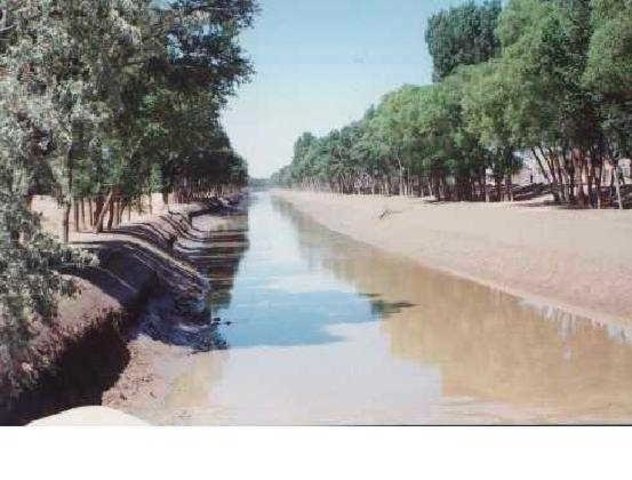
Shelterbelts for farmland in sandy areas [China]
Belts of trees, planted in a rectangular grid pattern or in strips within, and on the periphery of, farmland to act as windbreaks.
- Compilador: Meili WEN
2. Descripción del Enfoque MST
2.1 Breve descripción del Enfoque
The shelter belt is a strip or a row of trees planted in a farmland as a wind barrier to protect crops and reduce wind erosion.
2.2 Descripción detallada del Enfoque MST
Descripción detallada del Enfoque MST:
Aims / objectives: Overall purposes are improving environment, and then realization sustainable development of agriculture. Specific objectives are decreasing wind erosion of cropland, increasing foodstuff production. When this approach is decided to implement, the first things to be done are to investigate natural and social-economic environment. Then scope and stages of implementation are decided by government with provision of capital and policies. After that, the approach need to propagandize to people who live in the project area. To implement this approach step by step, local government and land users play an very important role in implementation of the approach.
2.3 Fotos del Enfoque
2.5 País/ región/ lugares donde el Enfoque fue aplicado
País:
China
Región/ Estado/ Provincia:
Inner Mongolia
Comentarios:
The data is from: Inner Mongolia forest department. Inner Mongolia autonomy region forest statistic data, 1987, p75.
Map
×2.6 Fechas de inicio y conclusión del Enfoque
Indique año del inicio:
1960
Año de conclusión (si el Enfoque ya no se aplica):
1981
2.7 Tipo de Enfoque
- proyecto/ basado en un programa
2.8 Propósitos/ objetivos principales del Enfoque
The Approach focused mainly on SLM with other activities (Modulation of air temperature, purifying air and increasing oxygen.)
The main objectives of the approach were reducing wind speed and keep soil moisture so as to be sustainable development of local land resources.
The SLM Approach addressed the following problems: Serious wind erosion in the farmland, and poor land management.
2.9 Condiciones que facilitan o impiden la implementación de la/s Tecnología/s aplicadas bajo el Enfoque
disponibilidad/ acceso a recursos y servicios financieros
- impiden
No enough money
Treatment through the SLM Approach: Raising funds from different level of government
marco de trabajo legal (tenencia de tierra, derechos de uso de tierra y agua)
- impiden
Lack of enforcement of legislation
Treatment through the SLM Approach: Enforcement of legislation
The existing land ownership, land use rights / water rights moderately hindered the approach implementation Persuading land users to accept this SWC approach.
3. Participación y roles de las partes interesadas involucradas
3.1 Partes interesadas involucradas en el Enfoque y sus roles
- usuarios locales de tierras/ comunidades locales
Mongolian, Moslem, Korean minority nationalities, etc
Work equally divided between men and women
- especialistas MST/consejeros agrícolas
A group of national and international specialists have been studying for a long time, and summarized this approach.
- gobierno nacional (planificadores, autoridades)
The implementing agencies are national government
3.2 Involucramiento de los usuarios locales de tierras/ comunidades locales en las distintas fases del Enfoque
| Involucramiento de los usuarios locales de tierras/ comunidades locales | Especifique quién se involucró y describa las actividades | |
|---|---|---|
| iniciación/ motivación | auto-movilización | public meetings; They were involved in approach by public meeting and understood the approach. |
| planificación | interactivo | ublic meetings; They involved approach by public meeting and understand the approach |
| implementación | auto-movilización | casual labour; They increased their income by participating casual labour |
| monitoreo y evaluación | interactivo | interviews/questionnaires; They pronounced their point of view by interviews or questionnaires |
| Research | interactivo | They do not participate in. |
3.4 La toma de decisiones en la selección de Tecnología(s) MST
Especifique quién decidió la selección de las Tecnología/ Tecnologías a implementarse:
- por políticos/ líderes
Explique:
consultative.
Decisions on the method of implementing the SLM Technology were made by mainly by SLM specialists with consultation of land users. directive (top-down).
4. Apoyo técnico, fortalecimiento institucional y gestión del conocimiento
4.1 Construcción de capacidades / capacitación
¿Se proporcionó la capacitación a usuarios de tierras/ otras partes interesadas?
No
4.2 Servicio de asesoría
¿Los usuarios de tierras tienen acceso a un servicio de asesoría?
Sí
Especifique si servicio proporcionado se realizó:
- en los campos de los usuarios de tierras
Describa/ comentarios:
On-the-job, farm visits, demonstration areas; Key elements: Quality of on-the-job, Effect of farm visits, Quality of demonstration areas; 1) Advisory service was carried out through: projects own extension structure and agents 2) Advisory service was carried out through: projects own extension structure and agents; Extension staff: mainly government employees 3) Target groups for extension: technicians/SWC specialists; Activities: Courses and demonstration
Advisory service is quite adequate to ensure the continuation of land conservation activities; All land users want to do this approach if they could get economic benefit from it. At each government level, there is a SWC division which is in charge of SWC activities including extension.
4.3 Fortalecimiento institucional (desarrollo institucional)
¿Se establecieron o fortalecieron instituciones mediante el Enfoque?
- sí, moderadamente
Especifique el nivel o los niveles en los que se fortalecieron o establecieron las instituciones:
- local
Especifique el tipo de apoyo:
- financiero
4.4 Monitoreo y evaluación
¿El monitoreo y la evaluación forman parte del Enfoque?
Sí
Comentarios:
bio-physical aspects were regular monitored by 0 through measurements; indicators: None
technical aspects were regular monitored by 0 through measurements; indicators: None
socio-cultural aspects were ad hoc monitored by 0 through observations; indicators: None
economic / production aspects were ad hoc monitored by 0 through measurements; indicators: None
area treated aspects were regular monitored by 0 through measurements; indicators: None
no. of land users involved aspects were ad hoc monitored by 0 through measurements; indicators: None
management of Approach aspects were ad hoc monitored by 0 through observations; indicators: None
There were few changes in the Approach as a result of monitoring and evaluation: Improving the approach according to the practical effect.
4.5 Investigación
¿La investigación formó parte del Enfoque?
Sí
Especifique los temas:
- economía/ marketing
- ecología
Proporcione detalles adicionales e indique quién hizo la investigación:
This approach is applied for improving environment so as to relief their poverty.
Research was carried out on station
5. Financiamiento y apoyo material externo
5.1 Presupuesto anual para el componente MST del Enfoque
Si no se conoce el presupuesto anual preciso, indique el rango:
- 10,000-100,000
Comentarios (ej. fuentes principales de financiamiento/ donantes principales):
Approach costs were met by the following donors: international (-): 25.0%; government (national): 55.0%; international non-government (-): 7.0%; national non-government (-): 3.0%; local community / land user(s) (-): 10.0%
5.2 Apoyo financiero/material proporcionado a los usuarios de tierras
¿Los usuarios de tierras recibieron financiamiento/ apoyo material para implementar la Tecnología/ Tecnologías? :
Sí
5.3 Subsidios para insumos específicos (incluyendo mano de obra)
- equipo
| Especifique qué insumos se subsidiaron | En qué grado | Especifique los subsidios |
|---|---|---|
| maquinaria | totalmente financiado | |
| herramientas | totalmente financiado | |
- agrícola
| Especifique qué insumos se subsidiaron | En qué grado | Especifique los subsidios |
|---|---|---|
| semillas | totalmente financiado | |
| fertilizantes | totalmente financiado | |
| seedlings and biocides | totalmente financiado | |
- infraestructura
| Especifique qué insumos se subsidiaron | En qué grado | Especifique los subsidios |
|---|---|---|
| community infrastructure | totalmente financiado | |
Si la mano de obra de usuarios de tierras fue un insumo sustancial, ¿fue:
- pagado en efectivo?
Comentarios:
Daily salary and materials as well as tools etc.
5.4 Crédito
¿Se proporcionó crédito bajo el Enfoque para actividades MST?
Sí
Especifique las condiciones (tasa de interés el apoyo, amortización, etc.):
Interest rate charged: 0.8%; repayment conditions: Varying every year, repayment is 5 years or 10 years..
Interest was lower than market rate.
6. Análisis de impacto y comentarios de conclusión
6.1 Impactos del Enfoque
¿El Enfoque ayudó a los usuarios de tierras a implementar y mantener Tecnologías MST?
- No
- Sí, un poco
- Sí, moderadamente
- Sí, mucho
This approach has little relationship to improve soil and water management.
¿El Enfoque mejoró cuestiones de tenencia de tierra/ derechos de usuarios que obstaculizaron la implementación de la Tecnologías MST?
- No
- Sí, un poco
- Sí, moderadamente
- Sí, mucho
The policies of land contract distribute land to individuals so that land users who involved in SWC activities need to be organized together for implementation of the SWC. The organization need much time and hard work.
Did other land users / projects adopt the Approach?
- No
- Sí, un poco
- Sí, moderadamente
- Sí, mucho
A comprehensive SWC technology/approach has been formed based on the single measure such as shelter belt, terrace, check dams involved in agricultural development.
6.3 Sostenibilidad de las actividades del Enfoque
¿Pueden los usuarios de tierras sostener lo que se implementó mediante el Enfoque (sin apoyo externo)?
- incierto
Si respondió no o incierto, especifique y comente:
If there are not support from outside, land users couldn't will implement SWC approach.
6.4 Fortalezas/ ventajas del Enfoque
| Fuerzas/ ventajas/ oportunidades desde la perspectiva del usuario de la tierra |
|---|
| Increasing their income (How to sustain/ enhance this strength: Increasing propagandizing and education about SWC knowledge.) |
| Fuerzas/ ventajas/ oportunidades desde la perspectiva del compilador o de otra persona de referencia clave |
|---|
| Improving agricultural production conditions. (How to sustain/ enhance this strength: Reinforcing management to this approach) |
| Increasing the land users' income (How to sustain/ enhance this strength: Changing part cropland to cash crops or fuit trees so as to get much return and maintain the sustainable SWC approach.) |
6.5 Debilidades/ desventajas del Enfoque y formas de sobreponerse a ellos
| Debilidades/ desventajas/ riesgos desde la perspectiva del usuario de la tierra | ¿Cómo sobreponerse a ellas? |
|---|---|
| Poor mamagement after the shelter belt construction. | Enhancing management of village communities forbidding deforest. |
| Debilidades/ desventajas/ riesgos desde la perspectiva del compilador o de otra persona de referencia clave | ¿Cómo sobreponerse a ellas? |
|---|---|
| Cost much money and more labour forces | The government should increase fund to implement this kind of approach. |
7. Referencias y vínculos
7.1 Métodos/ fuentes de información
- compilación de informes y otra documentación existente
7.2 Referencias a publicaciones disponibles
Título, autor, año, ISBN:
China atlas.China atlas publishing house, 1999, p25.
¿Dónde se halla disponible? ¿Costo?
Library of the Department of Resource and Environmental Science, Beijing Normal University.
Título, autor, año, ISBN:
Zhao Yu,Jing Zhengping, Shi Peijun, Hao Yunchong et al.Inner Mongolia soil erosion research remote sensing was used in Inner Mongolia soil erosion research,Science publishing house,1989, p25.
¿Dónde se halla disponible? ¿Costo?
Library of the Department of Resource and Environmental Science, Beijing Normal University.
Título, autor, año, ISBN:
Inner Mongolia forest department, Forest work manual,1998,12, p33-34, p67
¿Dónde se halla disponible? ¿Costo?
Library of the Department of Resource and Environmental Science, Beijing Normal University.
Título, autor, año, ISBN:
Synthesized investigate team in Inner Mongolia-Ningxia, CAS.West of northeast Forest in Inner Mongolia autonomy region, Science publishing house,1981, p82-101.
¿Dónde se halla disponible? ¿Costo?
Library of the Department of Resource and Environmental Science, Beijing Normal University.
Título, autor, año, ISBN:
Sun Jinzhu. Natural condition and reconstruct in Hetao plain,Inner Mongolia people's publishing house,1976, p188-189.
¿Dónde se halla disponible? ¿Costo?
Library of the Department of Resource and Environmental Science, Beijing Normal University.
Título, autor, año, ISBN:
Inner Mongolia forest Department. Inner Mongolia autonomy region forest statistic data,1987, p75.
¿Dónde se halla disponible? ¿Costo?
Library of the Department of Resource and Environmental Science, Beijing Normal University.
Título, autor, año, ISBN:
Hu Chun(chief editor). Inner Mongolia autonomy region climate resources about agriculture, forest and animal husbandry, Inner Mongolia people's publishing house, 1984, p45-47.
¿Dónde se halla disponible? ¿Costo?
Library of the Department of Resource and Environmental Science, Beijing Normal University.
Título, autor, año, ISBN:
Water and soil conservation bureau, Yellow River irrigation works committee of Department of water and electricity. Water and soil conservation economy benefit thesis collecting,1987, p45-47.
¿Dónde se halla disponible? ¿Costo?
Library of the Department of Resource and Environmental Science, Beijing Normal University.
Título, autor, año, ISBN:
Sun Jinzhu,Chen Shan(chief editor). Inner Mongolia environmental alarm beforehand and repair countermeasure. Inner Mongolia people's publishing house,1994, p132.
¿Dónde se halla disponible? ¿Costo?
Library of the Department of Resource and Environmental Science, Beijing Normal University.
Vínculos y módulos
Expandir todo Colapsar todosVínculos

Shelterbelts for farmland in sandy areas [China]
Belts of trees, planted in a rectangular grid pattern or in strips within, and on the periphery of, farmland to act as windbreaks.
- Compilador: Meili WEN
Módulos
No se hallaron módulos



